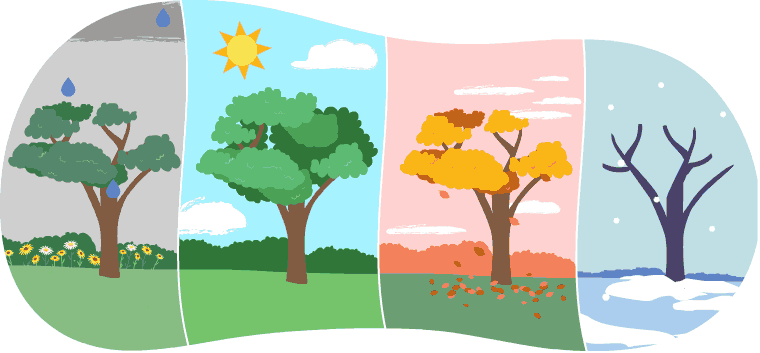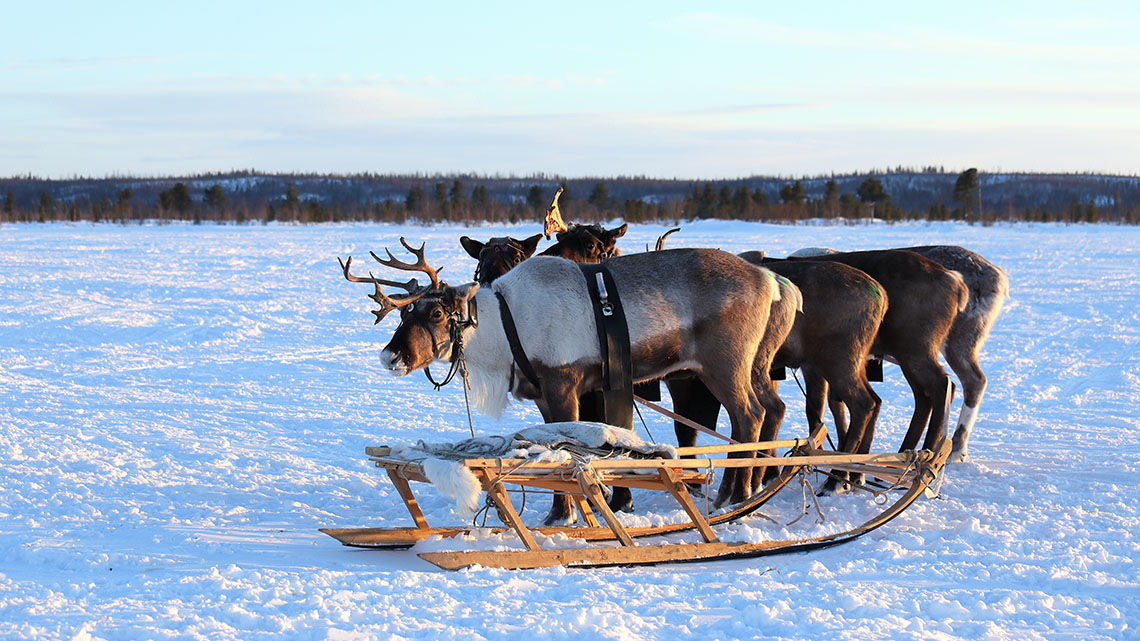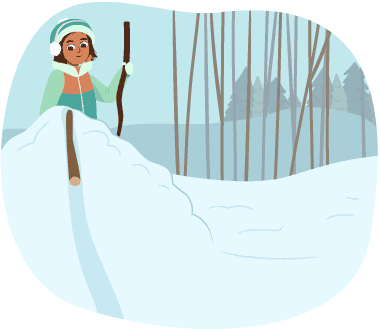Minds On
The land and the seasons

A tree in the four seasons. The first tree is beginning to grow and there is rain falling. The second tree is in full bloom and it is sunny. The third tree has yellow leaves which are beginning to fall to the ground. The fourth tree is bare and there is snow falling and covering the ground.
Understanding the land and the seasons where you live can help you to be prepared and allows people to have fun outdoors in each season.
Indigenous peoples in Canada understand the land and the seasons around them. They have learned this understanding from many years of living on the land. Each generation learns about the specific seasons, plants, animals, and the environment of that area.
Press ‘Definition’ to learn the meaning of the word Indigenous.
Indigenous is a word we use that means the first people who lived in Canada before anyone else, many for thousands of years.
This understanding has helped create games and activities during each season to entertain, celebrate, and give thanks as a community for these changes.

Inuit made the first toboggans from whale bones as a way to move loads across the ice. The word is from the Mi'kmaq word “tobakun,” which means sled.
Meet Cameron!
Learn more with Cameron, a young Mohawk boy from Six Nations of the Grand River, about an outdoor sport that he enjoys.
What are some of the outdoor winter activities you enjoy?
Check out this video to meet Cameron and discover a game called Snow Snake!
What did you notice about the game Snow Snake? What do you wonder about this game?
Record your ideas on the computer, on paper, or share with a partner, if possible.
Action
Snow study

Observe and plan
Observing: Studying the snow on different days, you can notice that sometimes it is…

Dry, fluffy snow

Wet, sticky snow
Planning: Let’s say someone wants to make a snow track. They would need just the right kind of snow. What kind of snow do you think would be best?
First, you are going to explore a video of children trying to make snowballs from fluffy dry snow. Do you think it will stick together well?
Now explore a video of a family making a snowman. They are using wetter, stickier snow. Does it stick together well?
What is your conclusion?
What kind of snow sticks together well?
Select the correct answer, then press "Check Answer" to see how you did.
Why would making a track out of sticky snow be best?
Record your answer.
Press ‘Answer’ to learn why making a track out of sticky snow would be the best.
To make a track, sticky snow is best – the kind you can make a snowball with. It works best for packing down to make the walls and the track so that they are smooth.
Snow sledding
Explore with the students at Hero Elementary as they plan their sledding adventure and choose just the right materials for their game.
How do they test out and choose what will slide well on the snow?
Record your answers.
Indigenous contributions and innovations
This learning activity features emerging technologies, STEM contributions, and Canadian innovations that are making a difference.

Did You Know?
Snow Snake
Cameron plays Snow Snake and it is called dehenenae:he in Kanyen’kéha (Mohawk) language. He builds the track in his yard with his family.
Many First Nations communities have been building and playing Snow Snake for many generations. Traditionally, Haudenosaunee men would play Snow Snake after they returned from a successful hunt. It was also a medicine game that helped the community during the long winter months.
Design challenge!
You are going to design a sliding track inspired by Cameron’s Snow Snake. (Note: you don’t have to make the track, just design it!)
Designing your sliding track
Brainstorming

Brainstorming is when you think about ideas like how to solve a problem.
Choose a location outdoors where you could design a long track inspired by Cameron’s Snow Snake.
Building with others might mean you can build many tracks and test out different designs or build a longer track than you could build alone.
Explore this carousel of images to help you think of ideas for your track.
Some important things to think about:
- think about a location where the track can be designed
- think about what day has just the right snow; you want to be able to pack it down, so the snow can’t be too fluffy
Planning

When you plan something, you think about the steps you have to follow and the materials you will need.
Before building, it is important to plan your design.
Draw your design using paper or the computer or describe your design using an audio recording. You can always make changes to your design if you want.
In Snow Snake, the track is sloped downward, and the track is dug into the slope from the top to the bottom.

The traditional Snow Snake is very long and narrow and straight, made from a strong wood like ash or hickory. Long Snow Snakes are about 2 meters in length and short Snow Snakes are about 1 meter long.
It’s important to choose just the right thing to slide on your track:
- Would it have a smooth surface?
- Would it be short or long?
Draw a picture or record an audio clip of what could be used as your “snake.” When Cameron and their friends play, they use long straight sticks carved from spruce wood.
Recording results
How will you measure your results?
- Design a way to measure whose throw goes the farthest.
- How will you keep track of this distance?
- How many throws will each person get?
Describe the game rules by creating a list, or an audio or video recording.
If possible, test out your plans and designs with others outdoors!
Checklist
When I create a design…
Consolidation
Check your learning!

In this learning activity, you have learned what is needed to create a Snow Snake track.
Think about it!
Answer these questions about Snow Snake on the computer, on paper, or share with a partner, if possible.
- How did the innovation of Snow Snake by Indigenous communities help people have fun in the winter?
- Can Snow Snake only be played in the winter? Is there a way to play this game any other time of the year?
Reflection
How do you feel about what you have learned in this activity? Which of the next four sentences best matches how you are feeling about your learning? Press the button that is beside this sentence.
I feel…
Now, record your ideas about your feelings using a voice recorder, speech-to-text, or writing tool.


